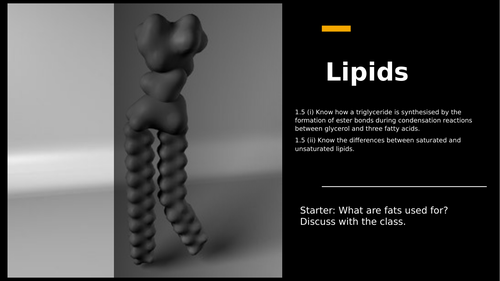Chemistry for Biologists (Biological Molecules)
Follows the Pearson Edexcel International AS/A Level Specification. Learning outcome:
1.1 Understand the importance of water as a solvent in transport, including its dipole nature.
1.2 (i) Know the difference between monosaccharides, disaccharides and polysaccharides, including glycogen and starch (amylose and amylopectin).
1.2 (ii) Be able to relate the structures of monosaccharides, disaccharides and polysaccharides to their roles in providing and storing energy β-glucose and cellulose are not required in this topic.
Core Practical 1: 1.3 Use a semi-quantitative method with Benedict’s reagent to estimate the concentrations of reducing sugars and with iodine solution to estimate the concentrations of starch, using colour standards.
1.4 Know how monosaccharides (glucose, fructose and galactose) join together to form disaccharides (maltose, sucrose and lactose) and polysaccharides (glycogen, amylose and amylopectin) through condensation reactions forming glycosidic bonds, and how these can be split through hydrolysis reactions.
1.5 (i) Know how a triglyceride is synthesised by the formation of ester bonds during condensation reactions between glycerol and three fatty acids.
1.5 (ii) Know the differences between saturated and unsaturated lipids.
2.6 (i) Know the basic structure of an amino acid.
2.6 (ii) Understand the formation of polypeptides and proteins (amino acid monomers linked by condensation reactions to form peptide bonds).
2.6 (iii) Understand the significance of a protein’s primary structure in determining its secondary structure, three-dimensional structure and properties (globular and fibrous proteins and the types of bonds involved in its three-dimensional structure).
2.6 (iv) Know the molecular structure of a globular protein and a fibrous protein and understand how their structures relate to their functions (including haemoglobin and collagen).
Content:
Lesson 1 - The Chemistry of Life
Bonding (Ionic, Covalent and hydrogen)
Importance of inorganic ions in Biology
Importance and properties of water
Lesson 2 - Carbohydrates
What are organic compounds?
Monomers and polymers
Mono-, di- and polysaccharides, and their chemical structures
Isomers
Bonds between sugars
Forming and breaking bonds between sugars
Testing for reducing sugars and starch
Lesson 3 - Lipids
What are lipids?
What are they used for?
Composition of lipids
Saturated and unsaturated fats and oils
Mono-, Di-, and triglycerides
Phospholipids (and their nature. But not their use)
Lesson 4 - Proteins
Amino acid structure
The types of amino acids
Peptide bonds and polypeptide chains
Prime-, second-, terti-, and quarternary structures
Bonds within proteins
Fibrous and globular proteins (Collagen and Haemoglobin as examples)
Conjugated proteins
Prosthetic groups
*Practical* ideas


